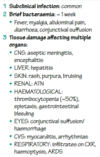Bacteria 11: Leptospirosis Flashcards
1
Q
What is the reservoir for leptospirosis?
A

2
Q
What is the life cycle of leptospirosis and how is it transmitted?
A
- Transmitted through ingestion of contaminated water, crack in skin/mucous memebranes while being contaminated water
- At risk:
- In the UK: water workers, electricians, triathletes
- Tropical regions: slum dwellers, rice farmers, associated with poverty
- Large outbreaks have been associated with floods, droughts and other disasters

3
Q
What kind of bacteria causes leptospirosis?
A

4
Q
What are the clinical features of leptospirosis?
A
- Initial bacteraemic phase followed by an immune mediated phase
- 75 - 100% will have fever, rigors, headache and myalgia
- Conjunctival suffusion or haemorrhage is an important diagnostic feature: up to 55% of patients
- Weil’s disease and leptospirosis sometimes used interchangeably, however refers to a specific triad of symptoms:
- Jaundice
- Thrombocytopaenia
- Renal Failure
- Renal failure can be quite severe, often requires RRT, but tends to resolve
- Pulmonary disease -> causes haemorrhage, mortality at 71%. 12% of people with leptospirosis develop pulmonary haemorrhage

5
Q
How do we diagnose leptospirosis?
A
- In UK: Serology - IgM elisa or microscopic agglutination test (gold stnadard but takes longer)

6
Q
How do we treat leptospirosis?
A

7
Q
What is the Jarisch-herzheimer reaction?
A
- Important in spirochaete disease as particularly common here
- Spectrum of severity
- This reaction occurs within 24 hours after antibiotic treatment of spirochaetal infections



